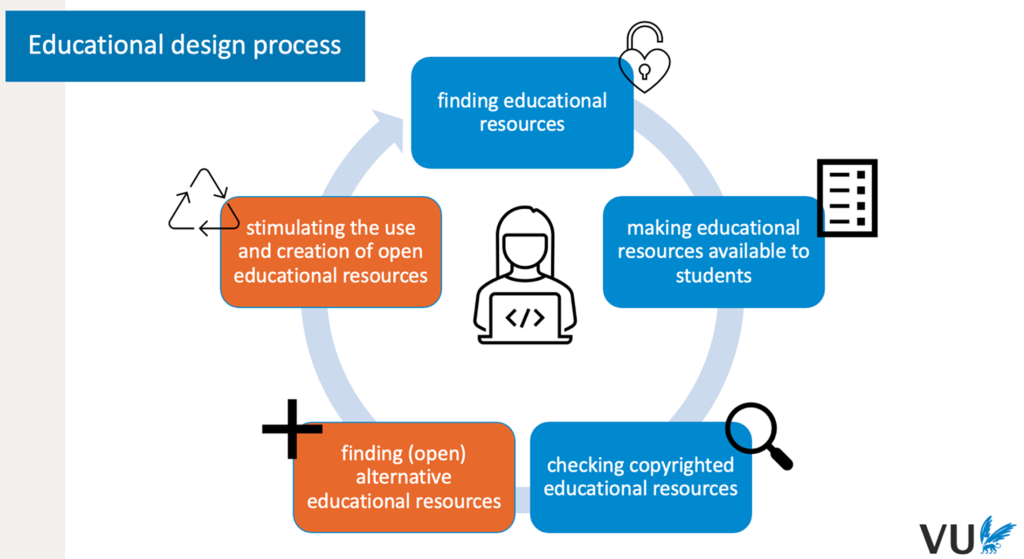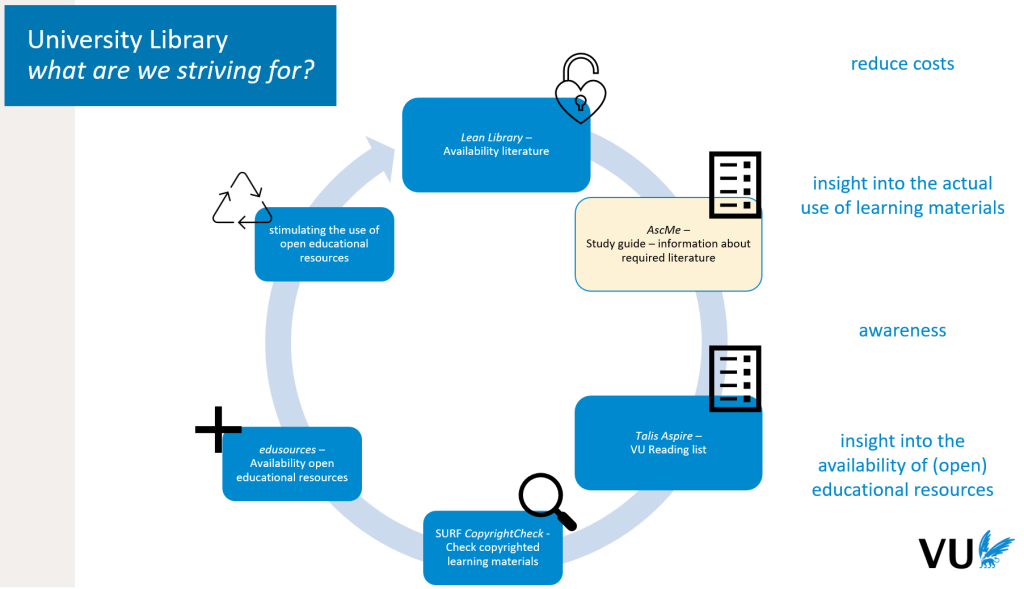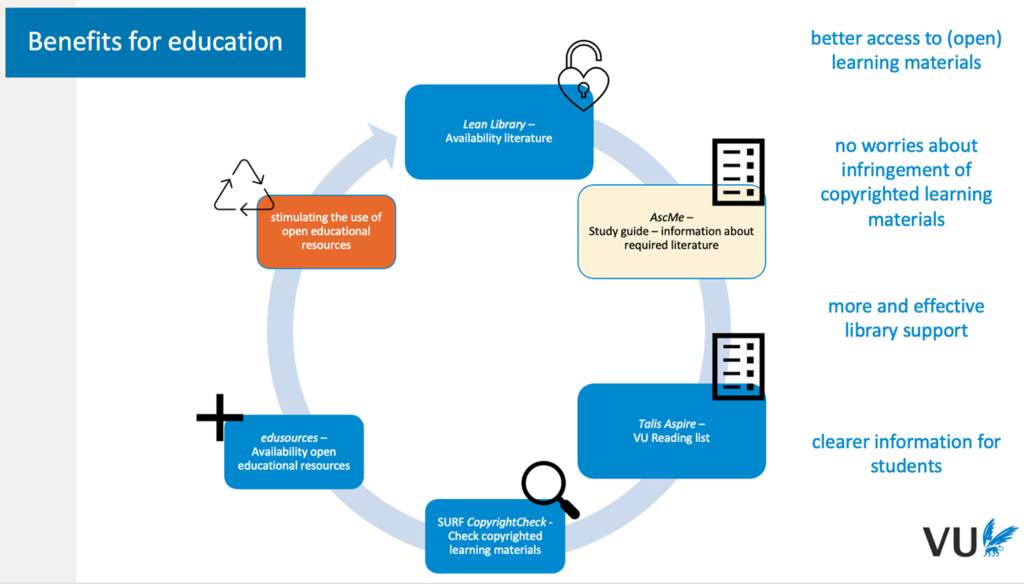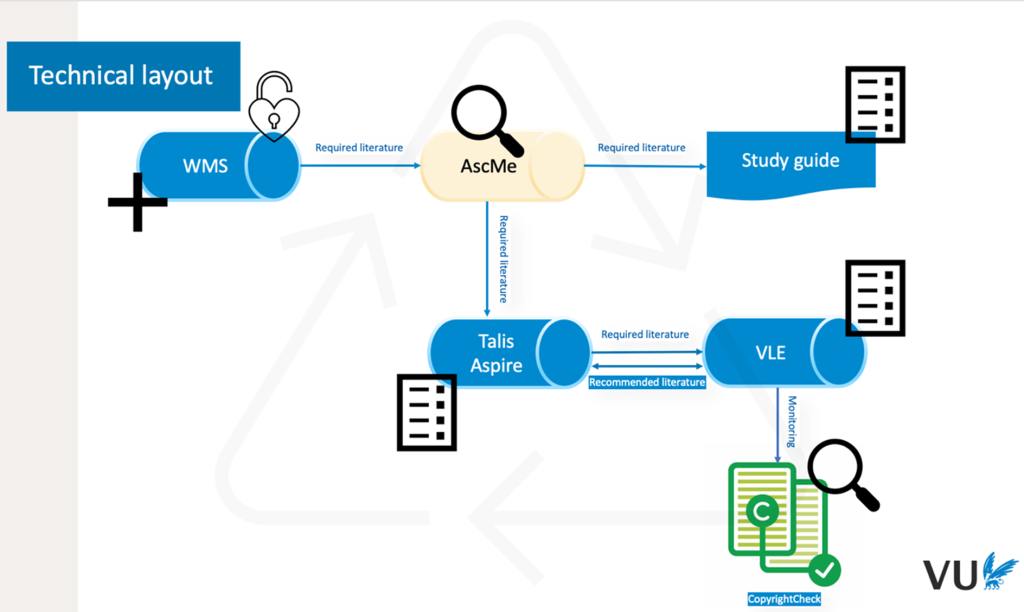Lean Library & Talis Aspire Case Study: Vrije Universiteit Amsterdam
Posted February 21st 2024
Posted February 21st 2024
In this case study, we look at how Vrije Universiteit Amsterdam is planning to introduce Talis Aspire, to use in conjunction with Lean Library, to increase the use of open educational resources, decrease possible copyright infringements of educational materials and reduce the library’s annual spending on academic content.

Complete the form at the bottom of this article to download this case study in Dutch.
De Vrije Universiteit Amsterdam (VU) is a large university with 9 faculties, more than 150 bachelor’s programs, pre-master and master programs with 31,761 students, of which 19,736 are Bachelor students and 12,025 are Master students. The university’s motto is: Don’t just become something, become someone. Since its founding in 1880, VU has stood for scientific and values-driven education, research and valorisation. VU members are free thinkers with expert knowledge and a Broader Mind. This way, VU works together to create a better world for people and the planet. VU focuses on a connected world; governance for society; human health and life sciences and science for sustainability. VU is diverse, sustainable and enterprising. 4671 people work at VU. The university library is an inspiring place for people and knowledge. Where learning material is found, and information is available for impact in science and society. The university library unburdens, connects and innovates.
For years both the university library management as well as the Educational Management were looking for a way to determine which content from their collection should be kept and made available. Additionally, lecturers used various methods to create and share their reading lists, resulting in confusion and possible infringements of copyrighted educational material.
The university library contributed to the development of innovations in collaboration with the VU Center for Teaching and Learning, conducting research into supporting resources that could improve the design of education. The university library, together with SURF and 4 other academic institutions, began the development of their SURF CopyrightCheck service, in addition to the promotion of Open Educational Resources (OER). This raised the following question: How does VU provide a clear overview of the learning materials available within their electronic learning environment?
After much thought and research, many possible solutions arose. The library educational support team was familiar with Talis Aspire, and was initially attracted to it for its management of the correct use of learning materials in education under copyright law. In the Netherlands, the Easy Access regulation is in use: an agreement between publishers and academic institutions over how to jointly reduce copyright infringements.
The Educational Support Department devised a plan in which various objectives and principles could come together, starting with encouraging the use and creation of open educational learning materials:

This design required supporting resources, benefitting both library and educational management. We strive for a change from a non-binding to a conscious use of learning materials.

From the task of organising the provision of learning materials to students more logically, the university library wondered what (innovative) tools were available. It took the VU two years of thinking, using already existing resources, to come up with a landscape (fig. 2).
The ideal workflow consisted of a lecturer finding content and providing this content to students, whilst ensuring that there are no possible issues around copyright.
How is this achieved? As described on the graphic above (fig. 2), VU begins by ensuring their provision has the correct tools for the job and that their systems are organized logically and in a structured manner to encourage the goal of stimulating the use of open educational resources.
This landscape has impacted the way lecturers are designing their course. The recommended workflow would begin with lecturers having Lean Library already installed on their browser and when they search for content online, it guides them to content that is already available in the library through WMS/OCLC. This creates a clear overview of actual available content, forming the core content of reading lists, provided to students via the VLE.
It is essential that the educators are involved in the collective responsibility for the proper use of learning materials. To effectively make this happen, one component in fig. 2 still needs to be developed: the AscMe – component. With this, educational management enters the required literature into the study guide, from which a reading list can then also easily be created. If this part can be implemented in the existing landscape, it will fully support the conscious use of learning materials.
During teaching periods, lecturers add more literature and additional information to courses in the VLE. To ensure all content is copyright cleared, it goes through SURF CopyrightCheck and then added to the VLE. Once in the VLE, educational management receive periodic reports of the usage that those materials have, giving a clear overview of available content, opening the opportunity to discuss how and what materials lecturers and educational management are using. This even presents an opportunity to recreate certain materials and making them open available (OER). VU’s ultimate goal is to encourage the use of open educational resources and open repositories, including adding new content to the Dutch service: edusources, where higher education – institutions work together to create, share and use content to enrich education.
In discussions with the educational staff, this landscape is the starting point to encourage the awareness process regarding the appropriate use of learning materials, without infringing copyrighted materials.
When this is implemented correctly, it has obvious benefits for education:

Essential in this process is supporting the conscious use of learning materials. VU has a very structured system to support the logistics of administrative and organizational support for education. The logistics of an educational program. This starts with collecting information about courses, people involved, schedules, study guides and the content within each course, indicating required reading for students and content they need to purchase in order to take the courses appropriately.
This process of gathering the necessary information makes up their educational program, VU refers to as the Academic Structure & Content Modelling Environment (AscMe). Together with the supplier (TimeEdit) the VU is working to expand opportunities of AscMe on providing literature-information. With the goal being that when a program director adds literature to AscMe, it will be -via Talis Aspire- directly integrated with VU’s LMS. This will mean that lecturers and students will always have the right information available on reading lists. With this landscape in place, VU will get greater usage insights and a nice overview of the required literature being used in education. This bridges the gap between lecturers and students when it comes to considering the right content, together with reducing copyright infringements.
From a technical perspective, everything was fairly easy to set up:

In summary, Talis Aspire provided a solution that would not only make reading lists easily available in education, but it contributed to the vision the VU has around the use of open educational resources. This included reducing copyright infringements and having learning materials easily available in the learning environment of students, in addition to a better and more efficient management of learning materials.
Adopting Talis Aspire had been a possibility for a while, but the institution was initially not ready until the creation of the educational support department of the university library. Insights were uncovered during the exploration stage, however Covid put the process on hold, with the final decision to adopt Talis Aspire made in the spring of 2022.
The use of Talis Aspire will be a gradual process, with information specialists and lecturers being informed about the implementation and inclusion during the set-up period. VU’s goal is to have Talis Aspire fully operational by the start of the 2024-2025 academic year. With the knowledge and experience that will be gathered from using Talis Aspire and CopyrightCheck, VU wants to convert non-binding into conscious use, in order to have the landscape fully integrated by 2025-2026. With the inclusion of Talis Aspire, VU want to make education ready for exciting new possibilities, matching the university’s vision of unburdening, connecting and innovating.
Collaboration with the Talis Aspire team has been a very smooth process, with a clear interest in each other’s wishes and respect for all (im)possibilities.
Cees van Gent, Head of Educational Support of the University Library, Vrije Universiteit Amsterdam
VU still are in the exploratory phase, so there is currently no hard data, however lecturers have been very enthusiastic over the possibilities offered by Talis Aspire and the library team are looking forward to gathering previously unavailable data. There has even been student feedback positively commenting on the initial VU reading lists, and the VU rector will soon share his favourite reading list to the entire academic community.
The communication strategy was not only aimed at users, but (especially) higher management was also approached and convinced. The Directors of Operations and the Vice Deans of Education of all faculties were informed in sessions about the possibilities of Talis Aspire (and SURF CopyrightCheck). The focus was on cost reduction and didactic possibilities. This has led them to advise making these resources available for education. They are now participating in the strategy to get the process accepted at VU.
VU’s goal is to have Talis Aspire fully operational in all education for the academic year 2024 – 2025. The experience gained with Talis Aspire (and CopyrightCheck) enable VU to change the optional, non-binding use into a conscious one, and thus to achieve the fully-integrated landscape in 2025 – 2026.
For the first time I have an overview what is really happening in education regarding the use of learning materials. Especially around the required literature we need to have available for students to prepare for their exams.
Cees van Gent, Head of Educational Support of the University Library, Vrije Universiteit Amsterdam
Watch back our webinar with Vrije Universiteit Amsterdam where we went over the core functionality of Talis Aspire, and Cees took us through:
If you’d like to hear more or receive a product demo, get in touch.
I’d like you to download the resource
"*" indicates required fields